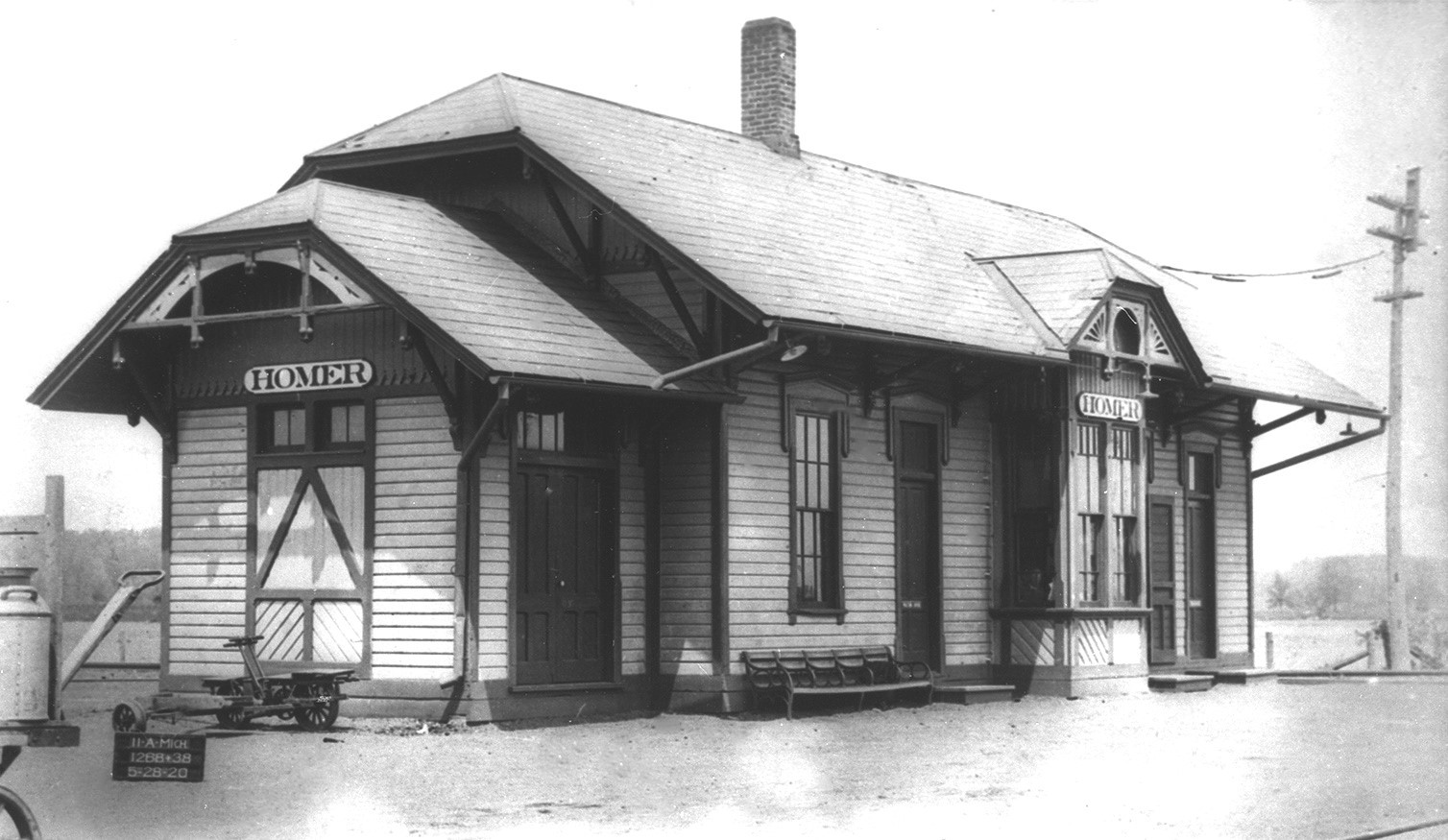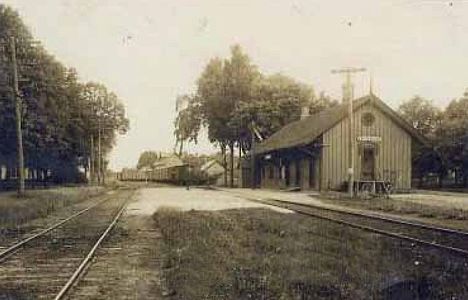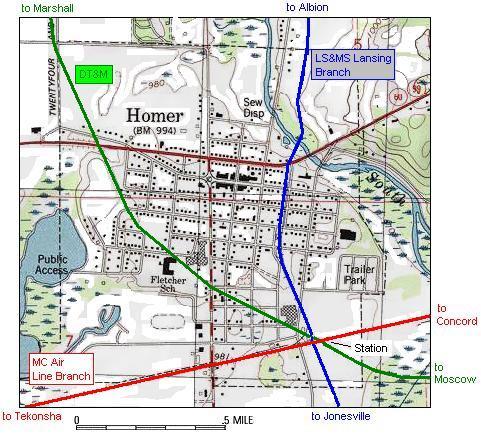- Details
- Hits: 4342
Station: Homer, MI



Image info: Top, the Michigan Central Depot at Homer, in a 1920 valuation photo. [CMUL]. 2nd photo, the Lake Shore depot at Homer. [Alan Loftis]. 3rd image, a USGS map of Homer with the three rail lines enhanced. Where the Lake Short crosses the river, the pilings for the trestle are still visible in 2003. The MC's Air Line right of way is still easily visible but the DT&M line is very difficult to follow. [Dale Berry]
Notes
Time Line
1870. Ten car loads of iron arrived for the Michigan Air Line railroad and track laying between Union City and Homer will be resumed immediately. One half of the track between Concord and Jackson has been ballasted and is quite smooth. [DFP-1870-0929]
1875. March 31. A freight train on the Michigan Central Air Line laden with live stock, was thrown from the track just east of Grub Hill yesterday morning, caused by a broken rail. A large number of cattle were killed some of which were drowned. The wreck caused but few hours delay of regular trains, which filled the main and side tracks for nearly a mile at the station in Homer. [HIX-1875-0331]
1879. The MC Air Line freight depot at Homer was broken into Thursday night and $60 taken. [DFP-1879-1101]
1896. At Homer, the LSMS Lansing branch served the Cortright Milling Company flour and feed mill on Byron Street. This mill had a single siding and a capacity of 125 barrels. It had a corn sheller, buckwheat cleaner, two separators, one dust collector, eight double sets of rollers and a wheat separator. The passenger station was south of Adams Street.
1917. The MC had an operator-agent here at the DT&M depot on the day shift. [TRT]
1920, On the Michigan Central Air Line, this is a passenger and freight agency. Interline tickets are issued. O. W. McDoll is the agent. The telegraph call sign is "HM". [MCOAS]
1925. April 21. Fire broke out at the NYC depot here at 4 o'clock Monday afternoon causing damage amounting to about $75. The blaze was confined to the roof about the chimney at the west end of the depot on the north side. The fire department was summoned and chemicals used. [BCE-1925-0421]
1966. November 11. Gas Threat in Train Wreck Creates National Interest. Residents of Homer were just rising at 7 a.m. November 11 when an explosion rocked their homes and hurtled the community of 1,500 across the front pages of the nation. The explosion was caused when 25 cars of a 118-car Detroit-bound freight train derailed and slammed into a bulk oil storage area on the southeast side of Homer.
Railroad officials at the scene blamed the derailment on a hot box. Intensifying the concern by law enforcement officials who rushed to the scene was the fact that two of the derailed cars contained vinyl-acetate and another, vinyl-chloride, chemicals which under certain heat conditions can unite to form a deadly gas called phosgene. The car had been used in World War 1. State police and sheriffs deputies evacuated the town and two schools as firemen from eight surrounding communities stood by to combat the fire, which burned for more than 10 hours. Mixed with the smell of chemicals was the stench of burning fruits, turkeys and vegetables, contained in refrigerated cars piled one atop the other in a mass of twisted steel and wood.
At 5 p.m. a chemical expert from the railroad declared the danger of poisonous gas over and weary Homer residents who had spent the day with relatives began returning home. No one was hurt. Twisted box cars laying at the side of the rails and the blackened shells of oil tanks remained as the only reminder of the near tragedy. [Hillsdale Daily News]
1870. September 29. The Air Line Railroad. From the Jackson Citizen. Yesterday ten car loads of iron arrived for the Michigan Air Line Railroad, and track laying between Union City and Homer will be resumed immediately. One half of the track between Concord and Jackson has been "ballasted," and is quite smooth. The company expects to earn the reputation of having one of the smoothest roads in Michigan, as well as one of the most direct routes through the State. The village of Concord, in this county, is quite lively now with railroad men. Everybody has boarders.
For a new road, mostly unballasted, it is very smooth near Homer. The fencing is in a fair state of progress, and telegraph poles are already being put up along the line. The passenger house at Homer is being pushed rapidly forward. The bridging and grading in Clarendon are now completed, and the iron from Homer to Tekonsha, to which place it is laid from the west, will be soon united. [DFP-1870-0929]
Bibliography
The following sources are utilized in this website. [SOURCE-YEAR-MMDD-PG]:
- [AAB| = All Aboard!, by Willis Dunbar, Eerdmans Publishing, Grand Rapids ©1969.
- [AAN] = Alpena Argus newspaper.
- [AARQJ] = American Association of Railroads Quiz Jr. pamphlet. © 1956
- [AATHA] = Ann Arbor Railroad Technical and Historical Association newsletter "The Double A"
- [AB] = Information provided at Michigan History Conference from Andrew Bailey, Port Huron, MI

